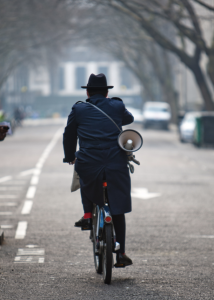MONTY SHIELD looks at the historical importance of Malet Street as a space of student protest.
On dreich winter days, Malet Street stands largely deserted, save for the odd huddle of students or a solitary parking attendant. But on others, it is radically transformed. Thousands of activists have found themselves entwined with this place as a political battleground. It was recently the meeting point for the last major dispute between campus workers and university management prior to the Corbyn surge: an arena for thousands of students to build up energy and march on Parliament.
I’ve been lucky enough to have been thrown into some of these movements since arriving as a student in London in 2013. On arrival at UCL, as an earnest young revolutionary with little experience of activism and labour struggle, I joined the 6am picket line of the ‘3 Cosas’ (Three Things) strike. This campaign, organised through the Independent Workers’ Union of Great Britain (IWGB), was a dispute was between outsourced cleaners at the University of London (UoL) Senate House and the UoL management. Most of the cleaners at Senate House are Latin American women who demanded decent sick pay, holidays and pensions above the dismal statutory minimum.
After months of strikes, freezing pickets and fundraisers which the socialist group ‘Alliance for Workers’ Liberty’ (AWL) played a prominent part in organising, management conceded and the strike won major benefits for the workers. The most famous picture of the strike is with John McDonnell and Jeremy Corbyn, before becoming leaders of the opposition, there on the picket in solidarity. At the time, the labour movement in Britain was at a historic low, and for many students, this was their first ever experience of class struggle at the picket line. We saw the dirty intimidation tricks of management, getting the police to film protesters from only few steps away. It was often dark and very cold when we started the pickets in the midst of winter. Workers, already on low pay, were just about getting by on the strike solidarity fund.

I was only on the periphery of the action, but still felt the sharp burst of triumphant energy and solidarity that swept through the workers and activists when we heard of our victory. If that was the feeling that radiated out to people like me, I can only imagine the intensity of feeling of those at the real centre.
Crucial to the student solidarity and action of the strike were the elected officers at the University of London Union (ULU), who were so radical in 2013/14 that the UoL management shut down the whole union out of justifiable fear for what successive elected communists intent on building a large democratic grassroots movement might get up to. The efforts at strike solidarity even led to one ULU officer being arrested for organising an unauthorised demonstration on Malet Street; he was hilariously apprehended moments after finishing a lunchtime gym session, and forced to spend the remaining few hours in a police cell contemplating potential charges (which never came to fruition) in his sweaty workout clothes.
On 4 December we occupied the UoL management corridor on Senate House, an experience I largely remember because of just how terrifyingly exciting it was to have been thrown in the deep end of student activism. Eight hours after entering we were violently evicted by security and police. An emergency ‘Cops Off Campus’ demo was called the next day. Malet Street became thick with tension as riot vans arrived one after the other. Hundreds of students gathered and chanted. Tension became anger, and excitement became fear. What had previously been the site of dreary strike mornings became violent as police lashed out and attacked protesters. Over 30 students were arrested and there were blood stains on the ground for a week after.
Malet Street should also always be remembered for years of demos for free education organised by the National Campaign Against Fees and Cuts (NCAFC). When it comes to demonstrations, there is something symbolic about this street, with its iconic overarching trees and its width obscured by tall buildings on either side. Thanks to its location at the heart of the Bloomsbury campuses, you can create, build and channel a great energy – and then see it let loose onto the rest of London. I have been involved in four NCAFC demos from 2013-2017, taking on more responsibility each time. In that time the ideas that activists fought and were very unpopular for in 2013 are now supported by huge swathes of students and workers across society. Malet Street protests kindled that idea year on year, kept it alive even as a pipe dream. For so many, the street is associated with powerful emotions and feelings: of exhaustion and defeat as well as happiness and intense pride.
The demonstration against Universities UK earlier this month was the first time I’d ever seen Malet Street in the snow. I was reminded of just how beautiful it is. Now we’re in the middle of the biggest dispute I’ve ever seen in the student movement and the largest student mobilisation since 2010, and there is an unprecedented focus on student solidarity with workers under attack. It was fitting to see the demo launched from the sight of so many key struggles that came before it. Long may these struggles continue to educate, agitate and demand justice in the name of crucial labour and student movements.
Monty Shield is an activist in the Alliance for Workers’ Liberty, and the London Representative on the National Campaign Against Fees and Cuts National Committee.

Featured image courtesy of Lazy South’s Travels.





